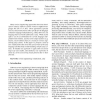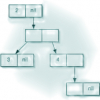JSAC
2010
14 years 2 months ago
2010
During the last years several operators have expressed concerns about the continued growth of the BGP routing tables in the default-free zone. Proposed solutions for this issue ar...
CL
1999
Springer
14 years 3 months ago
1999
Springer
It is well known that dynamic typing in languages like Lisp is costly in terms of performance. Besides the cost of tag checking, the other major source of ine ciency comes from th...
JUCS
2008
14 years 3 months ago
2008
Abstract: We describe in this paper the implementation and use of custom specializers in two current dialects of Lisp: Skill and Common Lisp. We motivate the need for such speciali...
USENIX
2000
14 years 5 months ago
2000
JEmacs is a re-implementation of the Emacs programmable text editor. It is written in Java, and uses the Swing GUI toolkit. Emacs is based on the extension language Emacs Lisp (El...
Publication
Most implementations of the language Refal represent ground expressions by doubly-linked lists, which results in low-cost concatenation. On the other hand, that representation nece...
CONEXT
2008
ACM
14 years 5 months ago
2008
ACM
The Locator/Identifier Separation Protocol (LISP) is one of the candidate solutions to address the scalability issues in inter-domain routing. The current proposals for its contro...
HOPL
1993
14 years 7 months ago
1993
Lisp is the world’s greatest programming language—or so its proponents think. The structure of Lisp makes it easy to extend the language or even to implement entirely new dial...
PEPM
1999
ACM
14 years 8 months ago
1999
ACM
Quasiquotation is the technology commonly used in Lisp to write program-generating programs. In this paper I will review the history and development of this technology, and explai...
CSMR
2008
IEEE
14 years 10 months ago
2008
IEEE
Many reverse engineering approaches have been developed to analyze software systems written in different languages like C/C++ or Java. These approaches typically rely on a meta-mo...
Book
"This book is intended to get you, the reader, programming quickly in Common Lisp.
Although the Lisp programming language is often associated with artificial intelligence,
t...






